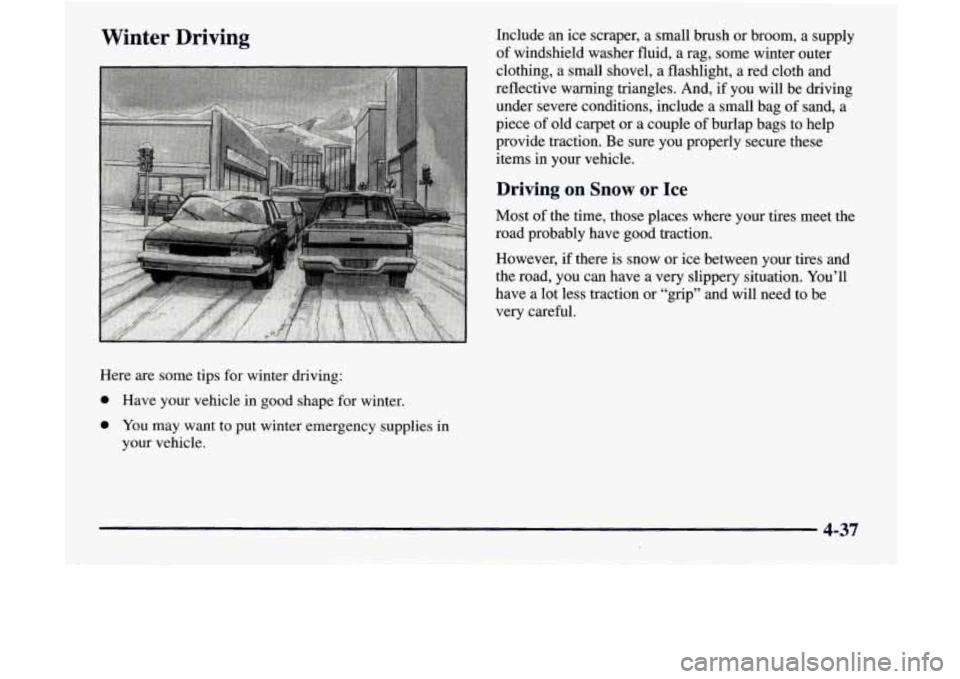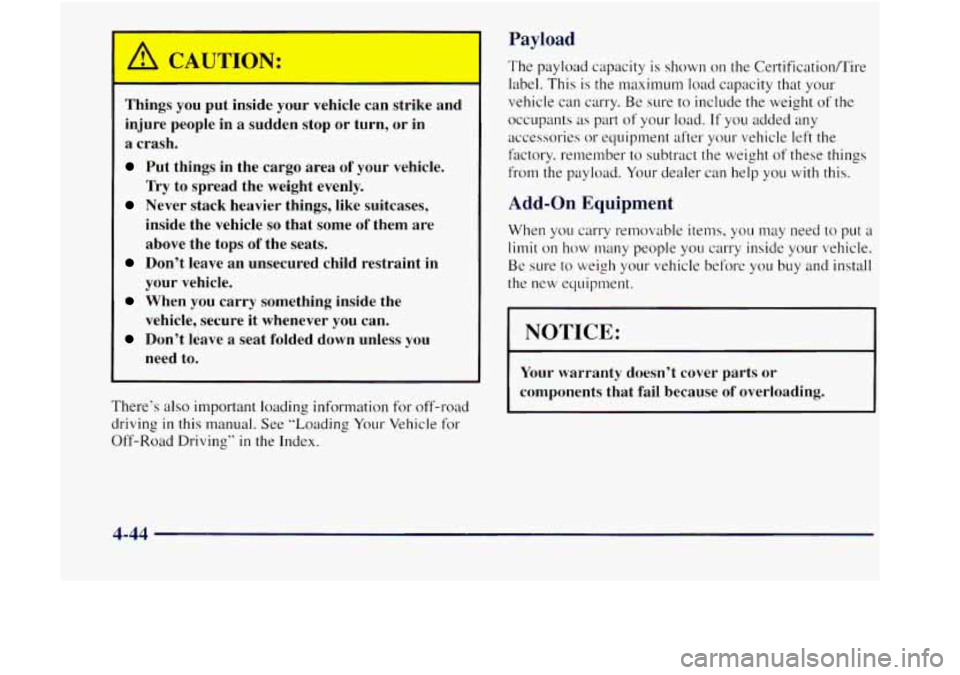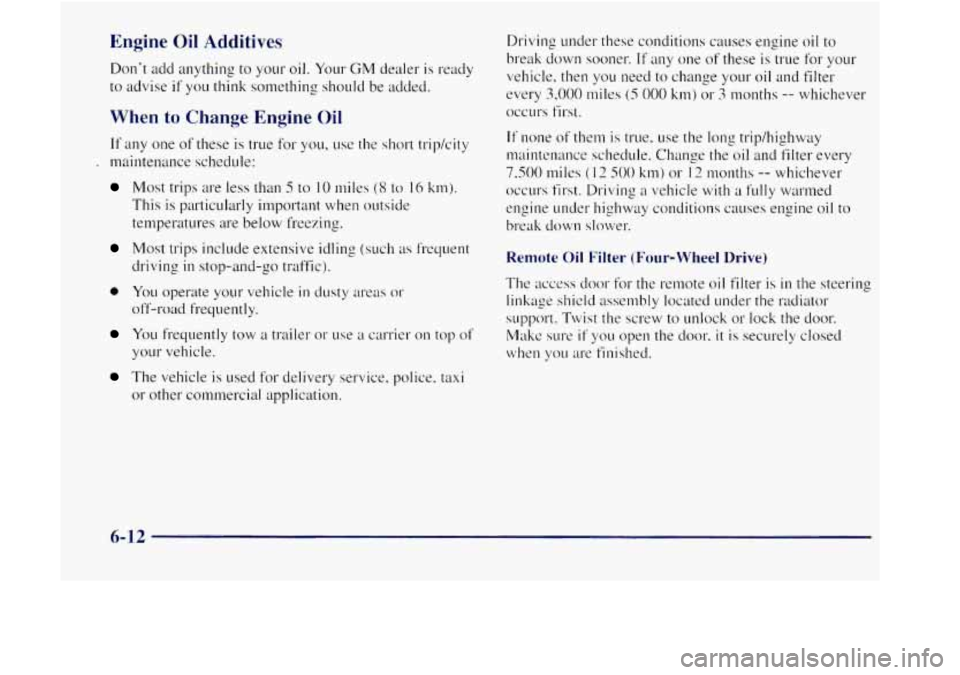ECU GMC JIMMY 1997 Owner's Guide
[x] Cancel search | Manufacturer: GMC, Model Year: 1997, Model line: JIMMY, Model: GMC JIMMY 1997Pages: 410, PDF Size: 20.03 MB
Page 202 of 410

Winter Driving
Here are some tips for winter driving:
0 Have your vehicle in good shape for winter.
0 You may want to put winter emergency supplies in
your vehicle. Include an ice scraper, a small brush or broom, a supply
of windshield washer fluid,
a rag, some winter outer
clothing, a small shovel, a flashlight, a red cloth and
reflective warning triangles. And, if you will be driving
under severe conditions, include a small bag
of sand, a
piece
of old carpet or a couple of burlap bags to help
provide traction. Be sure you properly secure these
items in your vehicle.
Driving on Snow or Ice
Most of the time, those places where your tires meet the
road probably have good traction.
However, if there is snow or ice between your tires and
the road, you can have a very slippery situation. You’ll
have a lot less traction or “grip” and will need to be
very careful.
4-37
Page 209 of 410

Things you put inside your vehicle can strike and
injure people in
a sudden stop or turn, or in
a crash.
Put things in the cargo area of your vehicle.
Try
to spread the weight evenly.
Never stack heavier things, like suitcases,
inside the vehicle
so that some of them are
above the tops
of the seats.
Don’t leave an unsecured child restraint in
your vehicle.
When you carry something inside the
vehicle, secure it whenever you can.
Don’t leave a seat folded down unless you
need to.
There’s
also important loading information for off-road
driving
in this manual. See “Loading Your Vehicle for
Off-Road Driving” in the Index.
Payload
The payload capacity is shown on the Certification/Tire
label. This
is the maxjInum load capacity that your
vehicle can carry.
Be sure to include the weight of the
occupants
as part of your load. If you added any
accessories
or equipment after your vehicle left the
factory. remelnber to subtract the weight of these things
from the payload. Your dealer can help you with this.
Add-on Equipment
When you carry rernovable items, yo11 may need to put a
limit 011 how many people you carry inside your vehicle.
Be sure to weigh your vehicle before you buy and install
the new equipment.
NOTICE:
Your warranty doesn’t cover parts or
components that fail because
of overloading.
4-44
Page 229 of 410

c A -T-l[BN:
To help avoid injury to you or others:
0
0
0
0
0
0
Never let passengers ride in a vehicle that is
being towed.
Never tow faster than safe or posted speeds.
Never tow with damaged parts not
fully secured.
Never get under your vehicle after it has
been lifted by the tow truck.
Always use separate safety chains on each
side when towing
a vehicle.
Never use J-hooks. Use T-hooks instead.
I
A vehicle can fall from a car carrier if it isn’t
adequatelJT secured. This can cause a collision,
serious personal injury and vehicle damage. The
vehicle should
he tightly secured with chains or
steel cables before it is transported.
Don’t use substitutes (ropes, leather straps,
canvas webbing, etc.) that can be cut
by sharp
edges underneath the towed vehicle. Always use
T-hooks inserted
in the T-hook slots. Never use
J-hooks. They
will damage drivetrain and
suspension components.
5-8
Page 254 of 410

Follow this diagram to store the llnderbody-mounted spare.
A. Retainer
B. Valve Stem
(Pointed
Down)
C. Spare 01- Flat Tire
D. Spring
E. Wheel Wrench
F. Lower
G. Raise
H. Hoist
Arm
1. Put the tire on the gro~~nd at the rear of the vehicle,
with the valve stem pointed down and to the rear.
2. Pull the retainer t11ro~1sh the wheel.
3. Put the chisel end of the wheel wrench, on an angle,
through
the hole in the rear bllmper and into the hoist
shaft. Turn the wheel wrench clockwise until the tire
is raised against the underside
of the vehicle.
You will hear two "clicks" when the tire is secure.
but p~111 on the tire to make SLII-e.
5-33
Page 256 of 410

Return the jack, wheel wrench and wheel blocks to the
proper location in your vehicle’s rear area. Secure the
items and replace the jack cover.
I /-A
I L
A. Retainer E Wheel Blocks
B. Rubber Band
G. Hub Cap Removal
(Some Models) Tool (Some Models)
C. Work Gloves
H. Wheel Wrench
D. Mat I. Jack
E. Jack Storage Cover J. Jacking Instructions
Make sure the tire and carrier are secure.
Driving with the tire or carrier unlatched could
injure pedestrians or damage the vehicle.
Compact Spare Tire (If Equipped)
Although the compact spare tire was fully inflated when
your vehicle was new, it can lose air after a time. Check
the inflation pressure regularly. It should be
60 psi
(420 Wa).
After installing the compact spare on your vehicle,
you should stop as soon as possible and make sure
your spare tire is correctly inflated. The compact
spare is made to perform well at speeds up to
65 mph
(105 km/h) for distances up to 3,000 miles (5 000 km),
so you can finish your trip and have your full-size tire
repaired or replaced where
you want. Of course, it’s best
to replace your spare with a full-size tire as
soon as you
can. Your spare will last longer and be in good shape in
case you need it again.
5-35
Page 271 of 410

Engine Oil Additives
Don't add anything to your oil. YOLK GM dealer is ready
to advise
if you think something should be added.
When to Change Engine Oil
If any one of these is true for you. LIS~ the short trip/city
. maintenxm schedule:
Most trips are less than 5 to 10 miles (8 to 16 km).
This is particularly important when outside
temperatures are below freezing.
Most trips include extensive idling (such as frequent
driving
in stop-and-go traffic).
0 You operate your vehicle in dusty areas or
off-road frequently.
YOLI frequently tow a trailer or use a carrier on top of
your vehicle.
The vehicle is used for delivery service, police, taxi
or other commercial application. Driving under
these conditions causes engine oil to
break
down sooner. If any one of these is true for your
vehicle. then you need to change your
oil and filter
every
3.000 miles (5 000 km) or 3 months -- whichever
occurs first.
Remote Oil Filter (Four-wheel Drive)
The ;1ccess door for the remote oil filter is in the steering
linkage shicld
assembly located under the radiator
support. Twist the
screw to unlock or lock the door.
Make sure
if you open the door, it is securely closed
when you are finished.
6-12
Page 307 of 410

Tire Chains
NOTICE:
If your vehicle has P235/75R15, P235/70K15 or
31xlOSOR15LT/C size tires, don’t use tire chains.
They can. damage your vehicle because there’s
not enough clearance.
Use another type of traction device only
if its
manufacturer recommends it for use on your vehicle and tire size combination and road
conditions. Follow that manufacturer’s
instructions. To help avoid damage to your
vehicle, drive slowly, readjust or remove the
device if it’s contacting your vehicle, and don’t
spin your wheels.
NOTICE: (Continued)
NOTICE: (Continued)
If you do hd a traction device that will fit, install
them on the rear tires.
If you have other size tires, use tire chains only
where legal and only when you must. Use only
SAE Class “S” type chains that are the proper
size for your tires. Install them on the drive axle
tires (,four-wheel-drive vehicles can use chains on both axles) and tighten them as tightly
as possible
with the ends securely fastened. Drive slowly and
follow the chain manufacturer’s instructions.
If
you can hear the chains contacting your vehicle,
stop and retighten them.
If the contact continues,
slow down until it stops. Driving
too fast or
spinning the wheels with
chains on will damage
your vehicle.
6-48
Page 399 of 410

Labels Certificatioflire
............................. 4-42
Fuse
....................................... 6-60
Safety Belt
.................................. 1-48
Service Parts Identification
..................... 6-58
Vehicle Identification Number
................... 6-58
Lamps
........................................ 2-45
Dome
...................................... 2-48
FrontMap
................................... 2-48
Front Reading
........................... 2-47, 2-51
Latches, Seatback
................................ 1-6
Leaving Your Vehicle
............................. 2-5
Leaving Your Vehicle with the Engine Running
....... 2-32
Air Bag Readiness
....................... 1-21, 2-73
Anti-Lock Brake System Warning
............ 2-76, 4-7
Brake System Warning
......................... 2-75
Charging System
............................. 2-73
Daytime Running Lamps Indicator
............... 2-80
Gate Ajar
................................... 2-81
Safety Belt Reminder
...................... 1-9, 2-72
Service Engine Soon
.......................... 2-77
Shift
.................................. 2-22, 2-80
Loading Your Vehicle
........................... 4-42
Locking Rear Axle
.............................. 2-23
LockoutSwitch
................................ 2-37
Interior
..................................... 2-47
OnReminder
................................ 2-4 6
Lighter
....................................... 2-61
Lights
CheckGages
................................ 2-80 Locks
......................................... 2-4
Door ........................................ 2-4
Key Lock Cylinder
Service ..................... 7-47
PowerDoor
.................................. 2-5
Rear Door Security
............................. 2-5
Steering Column Park Lock Check
............... 7-49
Loss of Control
................................ 4-13
Lubricants and Fluids
....................... 6-64, 7-52
Lubrication Service, Body
........................ 7-47
Luggagecarrier
................................ 2-59
Lumbar Controls
............................ 1-3, 1-4
Maintenance Record
........................... 7-55
Maintenance Schedule
............................ 7-1
Long Tripmighway
....................... 7-6, 7-30
Owner Checks and Services
..................... 7-46
Periodic Maintenance Inspections
................ 7-50
Recommended Fluids and Lubricants
............. 7-52
Scheduled Maintenance Services
.................. 7-4
Short TripKity
............................ 7-5, 7-7
Maintenance, Underbody
......................... 6-56
Maintenance When Trailer Towing
................. 4-54
Malfunction Indicator Lamp
...................... 2-77
Manual Front Seat
............................... 1-2
Manual Lumbar Support
.......................... 1-3
Manual Transmission Check
...................................... 7-47
Fluid
....................................... 6-18
Shifting
..................................... 2-21
Starting Your Engine
.......................... 2-16
9-6